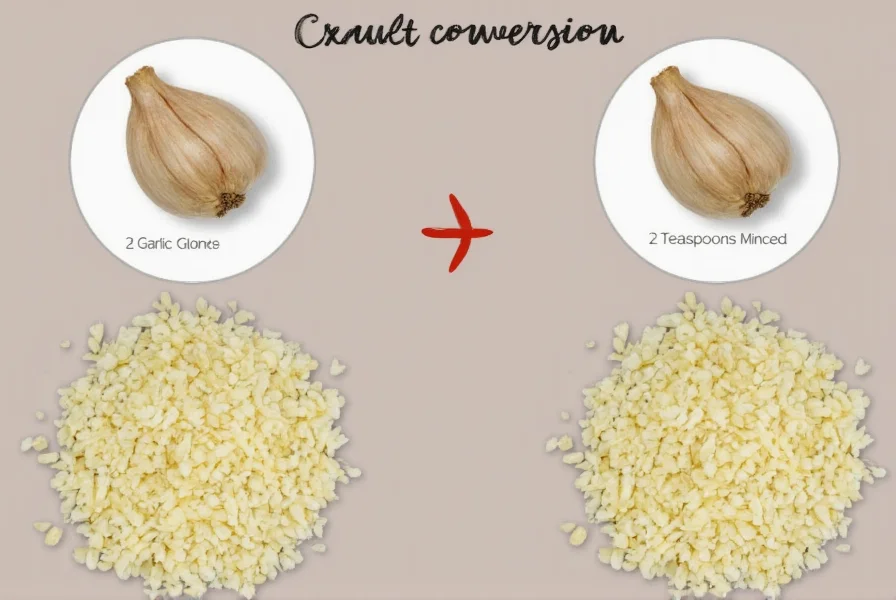Two medium-sized garlic cloves yield approximately 2 teaspoons of minced garlic. This conversion is essential for precise recipe execution, as garlic measurements directly impact flavor balance in dishes.
When following recipes that specify minced garlic but you're working with whole cloves, understanding this conversion prevents under- or over-seasoning. The exact amount can vary slightly based on clove size and mincing technique, but 2 cloves consistently translates to about 2 teaspoons of freshly minced garlic.
Understanding Garlic Measurements
Garlic measurements matter more than many home cooks realize. Using the wrong amount can dramatically alter a dish's flavor profile. While professional chefs often eyeball ingredients, precise measurements become crucial when learning new recipes or cooking for others with specific taste preferences.
Garlic cloves vary in size, which affects the final minced quantity. Here's a detailed breakdown of what to expect:
| Garlic Form | Equivalent Measurement | Notes |
|---|---|---|
| 1 small garlic clove | ½ teaspoon minced | About 1/2" diameter |
| 1 medium garlic clove | 1 teaspoon minced | Standard recipe assumption |
| 1 large garlic clove | 1½ teaspoons minced | About 3/4" diameter |
| 2 medium garlic cloves | 2 teaspoons minced | Most common recipe conversion |
| 3 medium garlic cloves | 1 tablespoon minced | Equal to 3 teaspoons |
Factors Affecting Garlic Yield
Several variables influence how much minced garlic you'll get from whole cloves:
- Clove size: Grocery store garlic varies significantly. Older bulbs tend to have larger cloves than fresher ones.
- Paper thickness: Some varieties have thicker papery skins, reducing the edible portion.
- Mincing technique: Hand-minced versus food processor minced produces different densities.
- Moisture content: Freshly harvested garlic contains more moisture than stored bulbs.
For the most accurate measurements in critical recipes, consider weighing your garlic. One medium clove typically weighs 7-10 grams before peeling.
Fresh Garlic vs. Pre-Minced Products
While fresh garlic provides superior flavor, understanding conversions for commercial products helps when time is limited:
- Jarred minced garlic: 1 teaspoon jarred ≈ 1 medium fresh clove (but flavor is less intense)
- Garlic paste: ½ teaspoon paste ≈ 1 medium clove
- Garlic powder: ⅛ teaspoon powder ≈ 1 medium clove (use sparingly)
Professional chefs overwhelmingly prefer fresh garlic for its complex flavor profile. The allicin compounds that create garlic's characteristic taste develop fully only when fresh cloves are crushed or minced.
Practical Kitchen Tips for Garlic Preparation
Maximize your garlic's flavor potential with these professional techniques:
- Peeling hack: Place cloves in a sealed container and shake vigorously to loosen skins.
- Even mincing: Sprinkle a pinch of salt over garlic before mincing to prevent sticking and create uniform pieces.
- Flavor control: Let minced garlic rest for 10 minutes before cooking to develop full flavor compounds.
- Storage: Store freshly minced garlic in an airtight container in the refrigerator for up to 5 days (though flavor diminishes quickly).
When Precision Matters Most
While many cooking applications allow for garlic measurement flexibility, certain dishes require precise conversions:
- Vinaigrettes and emulsions: Too much garlic can overpower delicate dressings
- Pasta sauces: Imbalanced garlic can dominate tomato flavors
- Marinades: Excessive garlic may toughen proteins
- Baking applications: Garlic bread and savory pastries need exact measurements
Understanding that 2 garlic cloves equals 2 teaspoons minced gives you the foundation for recipe adjustments. When doubling or halving recipes, maintain this proportional relationship rather than simply counting cloves.
Common Substitutions and Equivalents
Running out of fresh garlic? These substitutions maintain recipe integrity while using what's available:
- Garlic powder: Use 1/8 teaspoon powder per medium clove (ideal for dry rubs)
- Garlic salt: Substitute 1/4 teaspoon per clove, but reduce other salt by 1/8 teaspoon
- Garlic paste: 1/2 teaspoon paste equals one medium clove (check for added oils)
- Roasted garlic: 1 roasted clove ≈ 1.5 raw cloves in intensity
Remember that pre-minced garlic from jars contains preservatives that alter both flavor and cooking properties. When converting recipes specifying jarred garlic to fresh, use 50% more fresh garlic for equivalent flavor.
Frequently Asked Questions
How much jarred minced garlic equals 2 fresh cloves?
Two teaspoons of jarred minced garlic equals approximately 2 fresh garlic cloves. However, jarred garlic has about 30% less flavor intensity, so you may want to increase to 2.5 teaspoons for equivalent taste.
Does the size of garlic cloves significantly affect the minced measurement?
Yes, size matters considerably. Small cloves may yield only 1.5 teaspoons when minced, while large cloves can produce up to 2.5 teaspoons. For critical recipes, weigh cloves (7-10g each before peeling) or use the visual reference of one clove equaling the tip of your thumb.
Can I substitute garlic powder for 2 cloves of minced garlic?
Yes, substitute 1/4 teaspoon garlic powder for 2 minced garlic cloves. Remember that garlic powder is more concentrated, so start with less and adjust to taste. This substitution works best in dry rubs or soups where fresh garlic's texture isn't essential.
Why does my minced garlic measurement sometimes differ from recipe expectations?
Measurement variations occur due to clove size differences, moisture content, mincing technique, and even garlic variety. For consistent results, use a measuring spoon directly on your minced garlic rather than estimating from whole cloves, especially with heirloom or imported garlic which differs from standard grocery store varieties.
How should I store leftover minced garlic from 2 cloves?
Store leftover minced garlic in an airtight container in the refrigerator for up to 5 days. For best results, cover the garlic with a thin layer of olive oil to prevent oxidation. Never store minced garlic at room temperature, as this creates conditions favorable for botulism bacteria growth.











 浙公网安备
33010002000092号
浙公网安备
33010002000092号 浙B2-20120091-4
浙B2-20120091-4